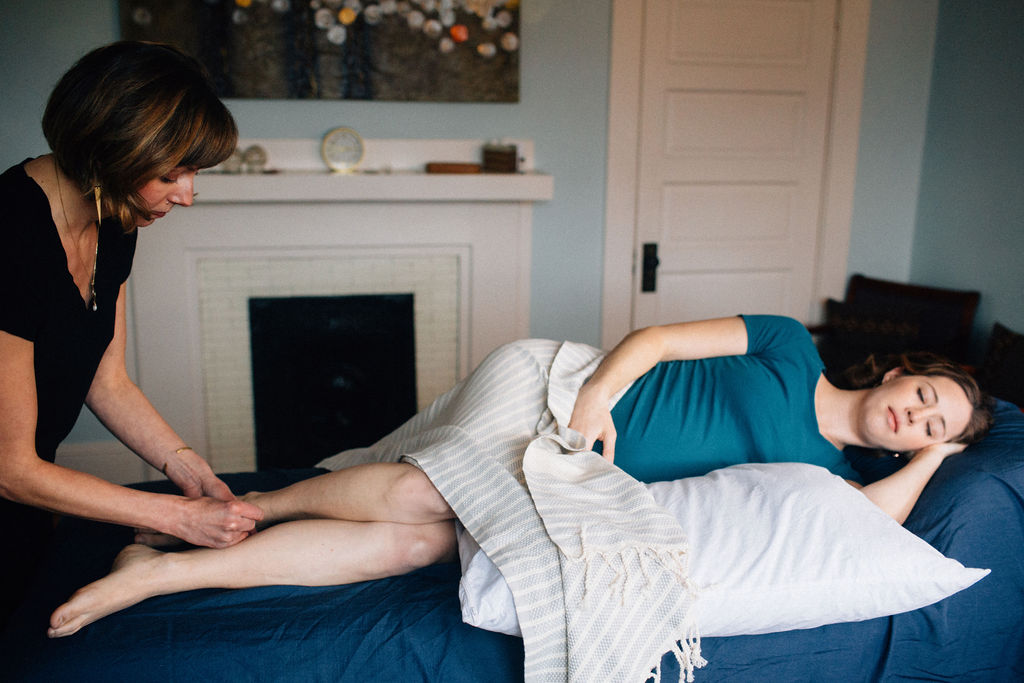Pregnancy is a long journey that brings joy and anticipation to the expecting parent. There are many milestones and hurdles along the way, one of which is understanding your baby’s position in the womb. Malposition in late pregnancy, such as breech (feet first), posterior (sunny side up), or transverse (sideways) can all lead to a lot of concerns and apprehensions as you are preparing for your baby’s arrival. Today’s discussion is about malposition and how East Asian Medicine can help optimize your baby’s position as you move closer to your due date.
A breech pregnancy occurs when baby’s head is positioned upward in the uterus, rather than facing downwards toward the birth canal. While uncommon, it may reduce the chances for a vaginal birth. This positioning can increase the complexity of labor and delivery, potentially necessitating a cesarean section if baby does not turn into a head down position by 38 to 39 weeks. Certain medical interventions are available, most commonly an external cephalic version, or ECV. While a version can be successful, it can be painful and create unnecessary stress for the birthing person and it can be helpful to consider other methods prior to an ECV. It is also helpful to combine the use of East Asian Medicine prior to having an ECV. Other alternative methods to help optimize baby’s position are acupuncture and moxibustion (moxa), specific exercises and stretches in Spinning Babies, pelvic floor physical therapy, and the Webster technique performed by chiropractors. Oftentimes we recommend a combination of each of these to help give baby the best chance to shift position. Each of these alternative methods are non-invasive approaches to help turn baby into the optimal position for delivery. In this blog, we will explore how acupuncture can offer support during a breech pregnancy.
Pregnancy can be accompanied by stress and anxiety, especially when you are being asked to shift your expectations and potentially change your birth plan upon discovering that your baby is not in a head down position. Acupuncture treatments are known to induce a sense of deep relaxation and tranquility, helping to provide a safe and calm space to process what you may be feeling while creating a more favorable environment for baby to adjust its position. Acupuncture also enhances the flow of Qi and blood in the body. When specific acupuncture points are targeted, it can gently encourage baby to move within the womb. By gently stimulating the uterus and surrounding tissues, acupuncture may facilitate baby in repositioning. Imbalances in the pelvic muscles and ligaments may also contribute to a breech presentation. Addressing these imbalances by targeting acupuncture points that correspond to the pelvis helps in softening tight muscles and encouraging proper alignment of the pelvis, creating more space for baby to turn head down.
Moxibustion is another technique that has been shown to increase the chance that a breech baby will turn to the head down position. It involves using the dried herb Ai Ye, or mugwort, to indirectly warm UB-67, an acupuncture point on the toe, to stimulate the baby to move. It is recommended to begin between weeks 34-35, for a minimum 30 minutes a day for ten days (15 minutes on each side). This is something that can be self-administered and done at home. Your acupuncturist can provide you with the tools to do this safely.
External cephalic version(ECV) is a medical procedure, and the most common intervention performed, to manually turn the baby from a breech position to a head-down position. Acupuncture can be used in conjunction with an ECV to improve its success rate and reduce discomfort during the procedure. Studies have shown that combining acupuncture with ECV may increase the likelihood of a successful version by 65%. However, it is important to keep in mind that these recommendations are only for uncomplicated pregnancies. If there are any complications such as abnormal amounts of amniotic fluid, fetal abnormalities, growth issues, vaginal bleeding, a bicornuate uterus, placenta previa, gestational diabetes, or hypertension, a different treatment plan may be needed. This is why it is of the utmost importance to consult your primary care physician and qualified acupuncturist prior to starting any form of treatment.
Acupuncture’s non-invasive nature, along with the potential benefits of relaxation, fetal movement stimulation, pelvic alignment, and complementing medical interventions, make it an excellent option for expectant mothers seeking additional support. As with any complementary therapy, it is essential to consult a qualified acupuncturist and inform your healthcare provider before proceeding. With proper guidance and care, acupuncture may serve as a valuable tool in promoting a breech baby’s natural repositioning, contributing to a smoother and more fulfilling birth experience.
If you would like to read more about the research surrounding moxa for breech care, head over to this link to read an exceptional article written by a fellow MAMPS graduate who is creating great work by reviewing up-to-date research on many important perinatal health topics.
Can Acupuncture or Moxibustion (Moxa) Help with Turning a Breech Baby?

